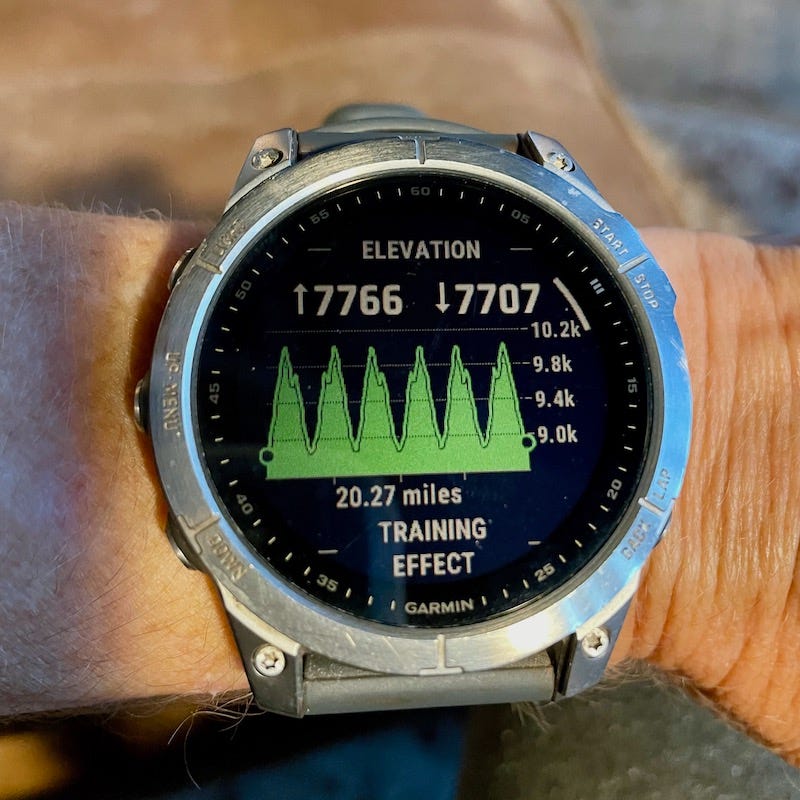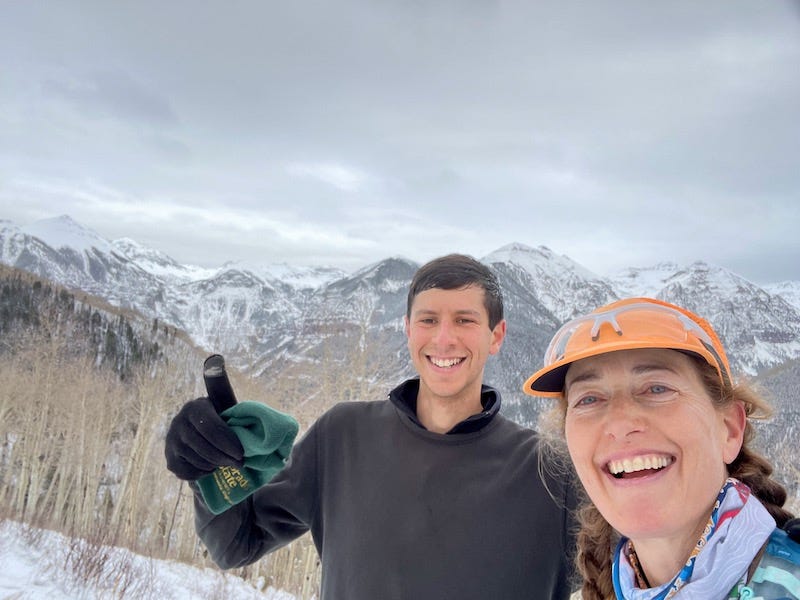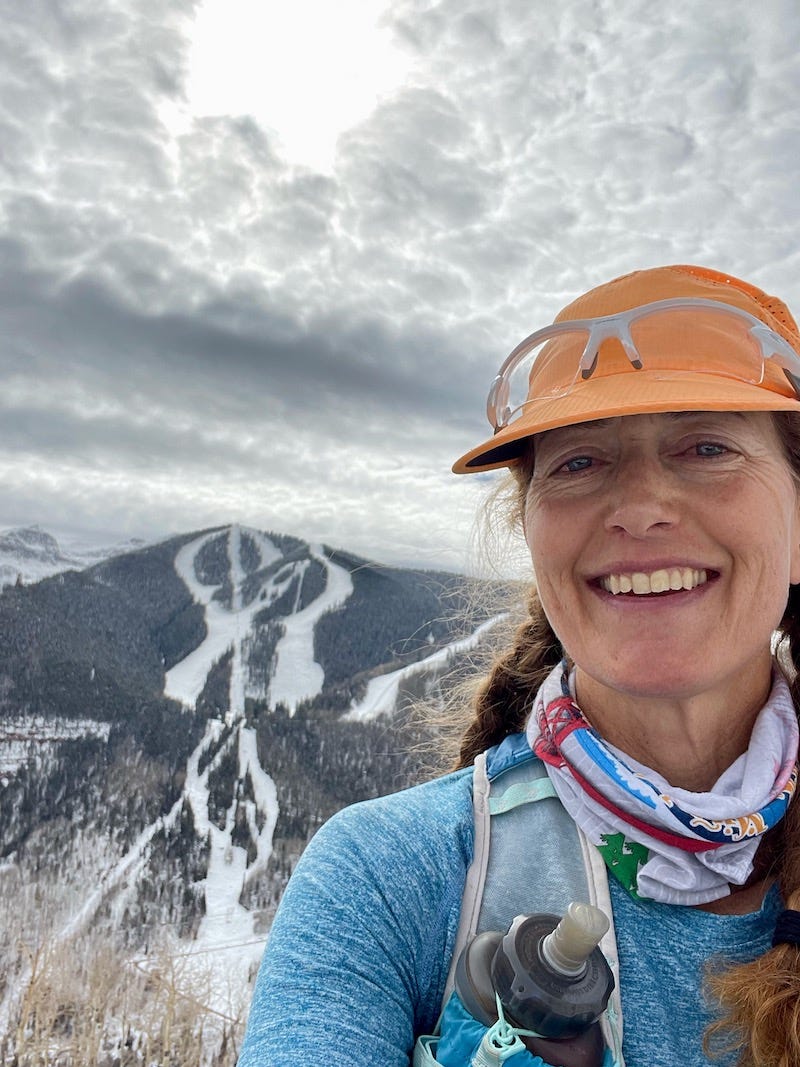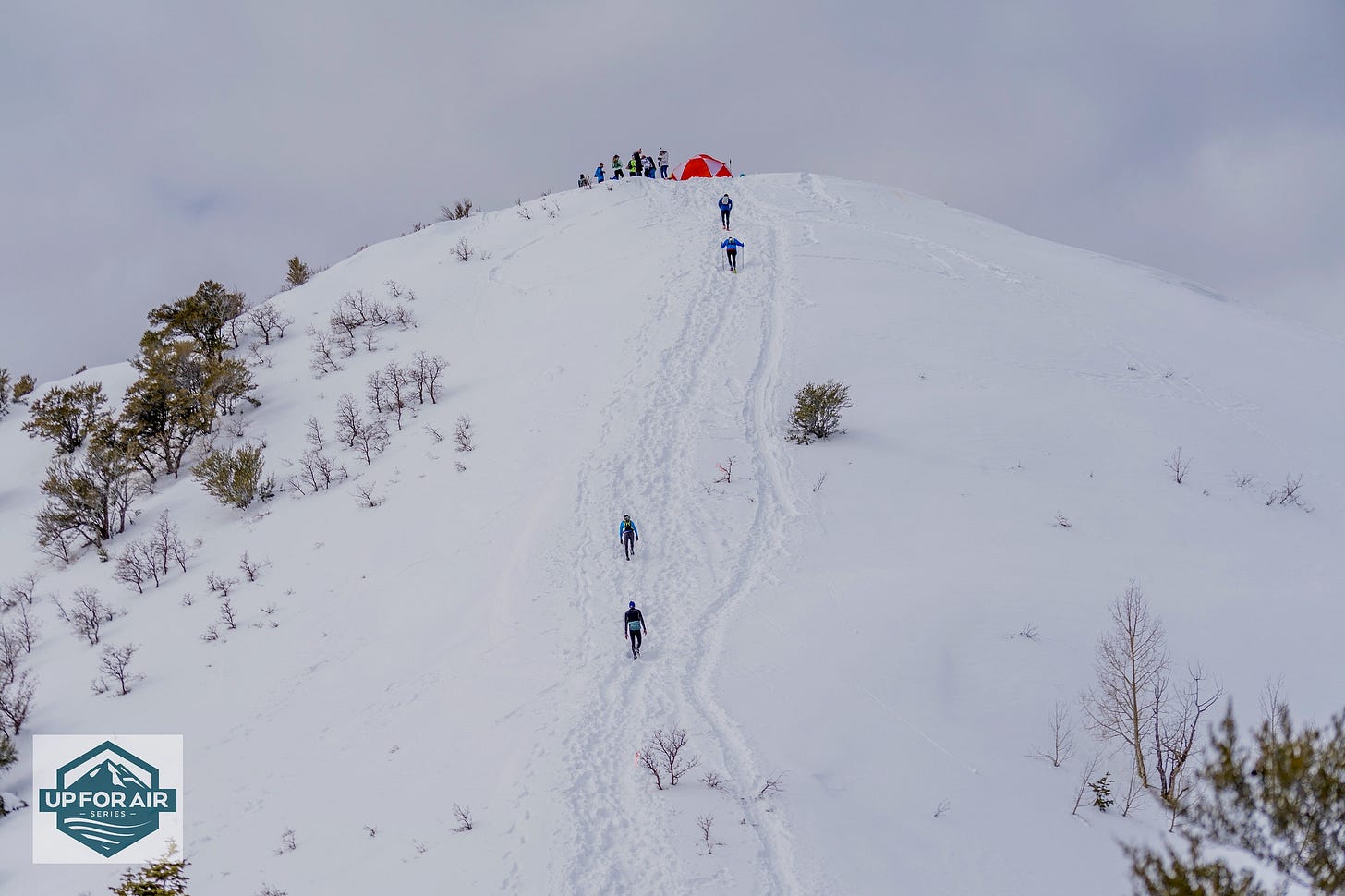Hello on day-after-Election-Day. If you need a break from election results and political news, read on, then get out for a run or hike. Last week, I launched the new Chat function on Substack’s platform. It’s great to connect with readers there! Please read this post, Let’s Chat, about how to join the conversation. You need the Substack app on your phone, and for now it’s only for iOS; they are still developing it for Android and the web.
Why a “fat ass”?
And just like that, the landscape turned to a mix of white snow and brown mud, and I started strapping spikes on my shoes to keep from slipping on ice.
On Sunday, I jumped into a winter-running challenge both foolish (because I was not adequately trained for it) and fortifying. I drove to Telluride a little before 6 a.m., grateful the time change meant it felt like 7 and the sun would rise soon. I had heard about an unsanctioned, un-permitted group contest to spend 12 hours doing laps on a local trail. The person who does the most laps “wins,” though all they’d get as a prize were bragging rights. The guys who organized it added several other challenges: fastest single lap, slowest single lap, most beers per lap, best Baby Bjorn lap (for carrying a baby).
The loop, on the horseshoe-shaped Jud Wiebe trail plus a side street connecting the two trailheads, is about 3.3 miles and gains 1200 feet of elevation. The non-event event was BYOA—bring your own aid (food and drink). Assume all risk and responsibility. If asked by other trail users, say it’s a casual run, not a race.
In other words, it was a group run in the tradition of “fat ass” ultras. The antithesis of organized, promoted, and increasingly expensive races, fat ass runs are informal, free, and fly under the radar so as not to get so big they create a nuisance or trigger the need for a permit. You don’t get a race result or a T-shirt or any other schwag. You don’t even get a timer, course markers, or a porta-potty. You’ve gotta use your own watch, your own GPS for navigation, and find a restroom nearby or discreetly go in the woods and leave no trace. It’s pure and simple.
I used to do an annual fat ass 50K to ring in the new year in the Oakland hills. Some fat ass ultras have become such a tradition, they’re now listed on Ultrasignup, most notably the infamous Hunter S. Thompson Fear & Loathing 50M.
But why are they called “fat ass”?
According to this March 1993 article in UltraRunning, “The Fat Ass 50 was started a few years ago by Joe Oakes of Los Altos, California, as a very low-key way of compensating for a bit of over-indulgence at the holiday dining table. The idea caught on. Next thing we knew, Joe was ‘selling’ franchises. The deal of setting up a franchise was the same as the deal for running any of the ‘races’—no entry fee, no aid, no awards.” The term “fat ass” stuck.
I carried a cooler full of my drinks and snacks, and a bag with fresh clothes, to a spot on the sidewalk where a trio of local guys said to meet. They drove up in a van as I arrived, and then they set out some folding chairs and got butcher paper and tape to put a giant sheet of paper on the side of the van. We would use a Sharpie to keep track of our laps on that paper.
Only a few of us started promptly at 6 a.m. Most others showed up later and started when they felt like it. Admittedly, I felt a bit out of place at the start. I was the only woman and the oldest by far. The others were way, way out of my league as runners. One guy recently placed 4th at the Bear 100. Another won this year’s Imogene Pass Run and Hanging Flume 50K. Another just won the new UTMB 50K race in Mexico.
The cool thing was, because of the format of this group effort, I could share the trail with them. I was the tortoise, and I would take a little more than an hour to do a lap, but I spent hardly any time resting at the van. Those guys would blaze through a lap in around 40 minutes, and then they’d hang out, change their sweaty shirts, eat breakfast, talk shit with others who stopped by, and thoroughly recover for 15 to 20 minutes before setting out on another fast-paced lap. Then they’d catch up to me, so I’d get to say hi and watch with admiration as they smoked the snowy trail, no poles in hand, no traction on feet, just flying.
Eventually, some other women showed up so I wasn’t the only one out there. We did the laps washing-machine style, alternating clockwise with counterclockwise direction, which made for a lot of fist-bumping social interactions.
I set out with a base goal of spending at least 6 hours on the trail and getting to 20 miles, but I hoped to do a marathon (8 laps x 3.3 = 26 miles) and maybe stretch to 9 laps and a fraction to hit 30. The first two laps felt giddy. What a wonderfully weird, invigorating way to start the day! I powerhiked the uphill and hammered down the downhill, delighted that the ankle-rolling rocks were buried under snow, and my poles and traction devices kept me from slipping.
By lap 3, fatigue started to work its way into my calves going uphill and quads going downhill. Steep portions became more slick and slippery with the repeated trail use and the warming sun. I took a longer break, gulped some chicken noodle soup I brought in a Yeti, and kept going onto laps 4 and 5. I listened to the haunting and fascinating new podcast series We Were Three, which tells a story of family dysfunction with polarized politics and covid consequences. Yikes, not very uplifting, but thought provoking! Then I took my Airpods out and focused on the beauty of the box canyon for what would turn out to be my final lap.
By lap 6, I was so tired, I became increasingly clumsy. I felt as if I were in a game like Chutes & Ladders called Slip & Trip. The trail terrain had turned into a never-ending playground slide that nature covered with slush the consistency of Slurpees. I don’t know how those speedster guys could keep running down—and even up—the slippery slope. I was slogging uphill and putting on the brakes as I skidded downhill, 1200 feet up, then 1200 feet back down, on each high-altitude lap.
By lap 6, approaching 20 miles total, I had accumulated over 7000 feet elevation gain. I could handle that if I were trained for it. But I haven’t done serious vert training since the Telluride Mountain Run in August. All of the lateral movement while sliding and tension from braking were taking their toll. I thought about our upcoming trip to hike in Peru, and I didn’t want to fall and make my knees or lower back hurt more than they already were hurting.
So, six laps, and I was done—and happily satisfied! At least two guys made it to 10 laps by the late afternoon. I felt grateful that the group effort made me do more than I would on my own and delighted that a new generation of ultrarunners is carrying on the fat ass tradition.


These laps on a steep, snowy trail reminded me of an ultra I did in February 2020, on snow-covered Grandeur Peak above Salt Lake City, which was part of the Running Up for Air (RUFA) series. This series of timed events (6, 12, and 24 hour) aims to raise money and awareness about air pollution, in particular the wintertime inversion layer that creates unhealthy air in many mountain cities.
I had a blast and won the 12-hour division at the Grandeur Peak event, getting to around 30 miles and 13,000 feet of elevation gain. This winter, RUFA events—along with a couple of Climbing Up for Air events—take place in Utah, Washington State, Montana, and Colorado. The Colorado one is February 24 in Staunton State Park, 45 minutes from Denver, and since I’ve run or slogged through snow there, I just might work it into my 2023 calendar. Learn more about the RUFA series from their website or this story I wrote for UltraRunning and consider one of their events.
What you need to know for safe winter running
Now that snow is here in southwest Colorado, I’ll share some winter running tips:
Trail running is virtually impossible when deep snow reduces your steps to post-holing, and it’s risky due to avalanche danger and the difficulty of navigation. But you can log high-quality runs on hard-packed snow on plowed roads. Just take the following precautions.
Get traction. Slipping on ice is one of winter running’s biggest risks. Investing in a traction device that straps onto your shoes is an easy, effective way to prevent slipping. My favorite is Kahtoola’s EXOspikes, because their spikes are effective but minimal enough that you can run with them on melted-out snow-free patches.
Dress in layers. Remember, if you’re comfortable when you start your run, you’ll feel too hot in about a mile, so don’t over-dress. I recommend running tights, a long-sleeve wool base layer, and a medium-weight jacket with vents. If it’s extra cold, add a fleece pullover under your jacket, which you can tie around your waist if you get too warm. Wear a beanie on your head and a buff or other type of layer around your neck that you can pull up to warm your cheeks and lips. Wear thick gloves and bring hand warmers to put in them. Ski goggles work well in lieu of sunglasses for stormy, low-light conditions and for added warmth on your face.
Don’t neglect hydration. You will be breathing hard and sweating under your layers, in extra-dry cold air, so you need to replace fluids as you run. Avoid using a reservoir in a hydration pack during winter runs, because liquid in the long tube can freeze. Instead, carry soft-flask bottles in a pack and fill them with hot water, so the water will be warm when you drink.
Keep the intensity of effort relatively low. Breathing hard in very cold, dry air can lead to exercise-induced bronchospasm, in which the dried-out airways of your lungs trigger an inflammatory response, causing the airways to narrow and produce mucus. This in turn can cause shortness of breath, coughing, and wheezing. In short, wintertime conditions can be hard on your respiratory system. To moderate the risk, run at a slower, easier pace. If you want to do high-intensity speed intervals, then head inside for a treadmill workout.
Beware of the “umbles”: The mumbles (slow, slurred speech), stumbles (stiffness and loss of muscle control), grumbles (unusual grumpiness or change in behavior), and fumbles (loss of dexterity) are warning signs of hypothermia. If you notice you or your running partner acting “umbly,” it’s time to get back to your car and turn the heater on, or go inside, ASAP!
Don’t go to extremes. If you feel truly uncomfortable running outside due to the cold and snow flurries, and you feel your extremities going numb, then go inside to warm up and work out. Or wait until midday when the sun is overhead, and temperatures climb to the teens or higher.
I hope you’ll share your winter running tips in the comments below.
And lastly—
Someone else who has a Substack newsletter produced an interesting and thought-provoking short documentary on the most popular Colorado 14ers and efforts to manage the crowding and the mountain’s ecosystem. If you care about Colorado’s mountains and you’re a fan of peak-bagging, I encourage you to watch “The Alpine Amusement Park” by
of .Related posts:
Our subscriber online meetup is happening November 16, 5 p.m. Mountain. Upgrade to a paid subscription to take part!












Love the idea of the "fat ass" event! Thanks for the shout out as well!
I wish there were more Fat Asses. Maybe we’ll see a resurgence as ultras become more expensive and harder to get into?
Every year on New Years Eve day there is a Fat Ass here in Portland called the Purge and Splurge. Everyone shows up at the zoo parking lot and carpooling is arranged to head to the northern Wildwood trailhead, then we all run the 30.2 miles back to our cars via the Wildwood trail in Forest Park. I’ve run it most years I’ve lived here, and hope to again this year.